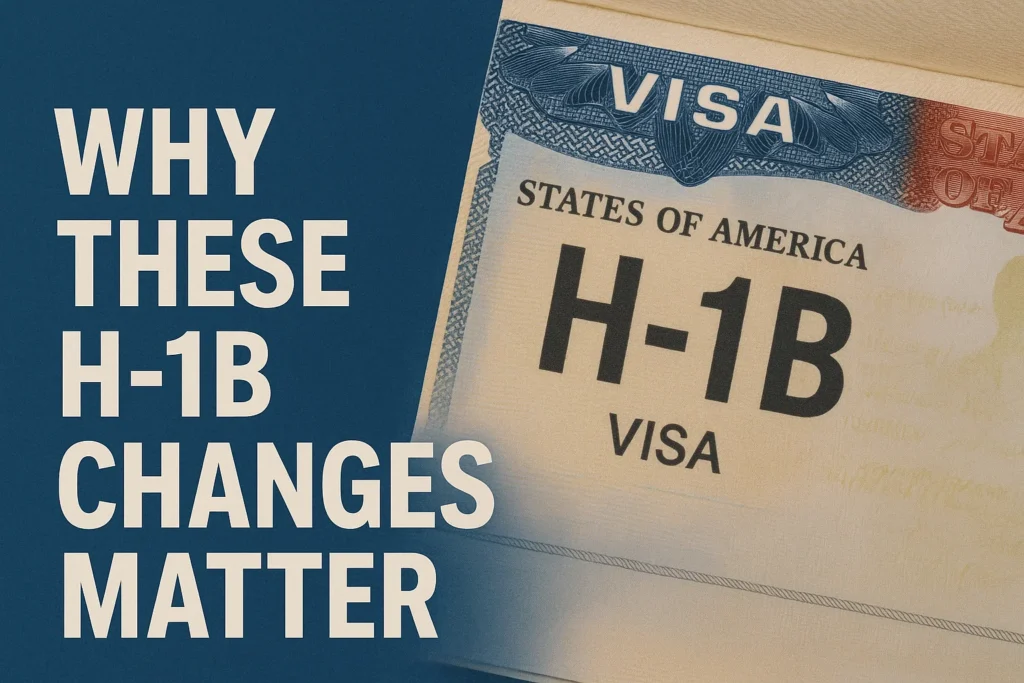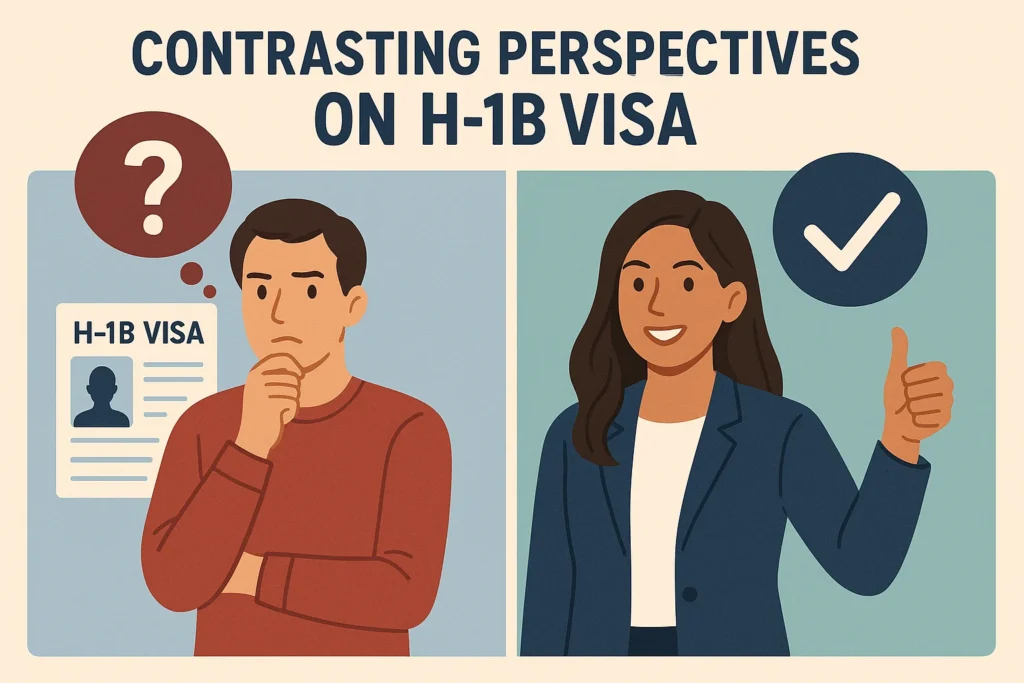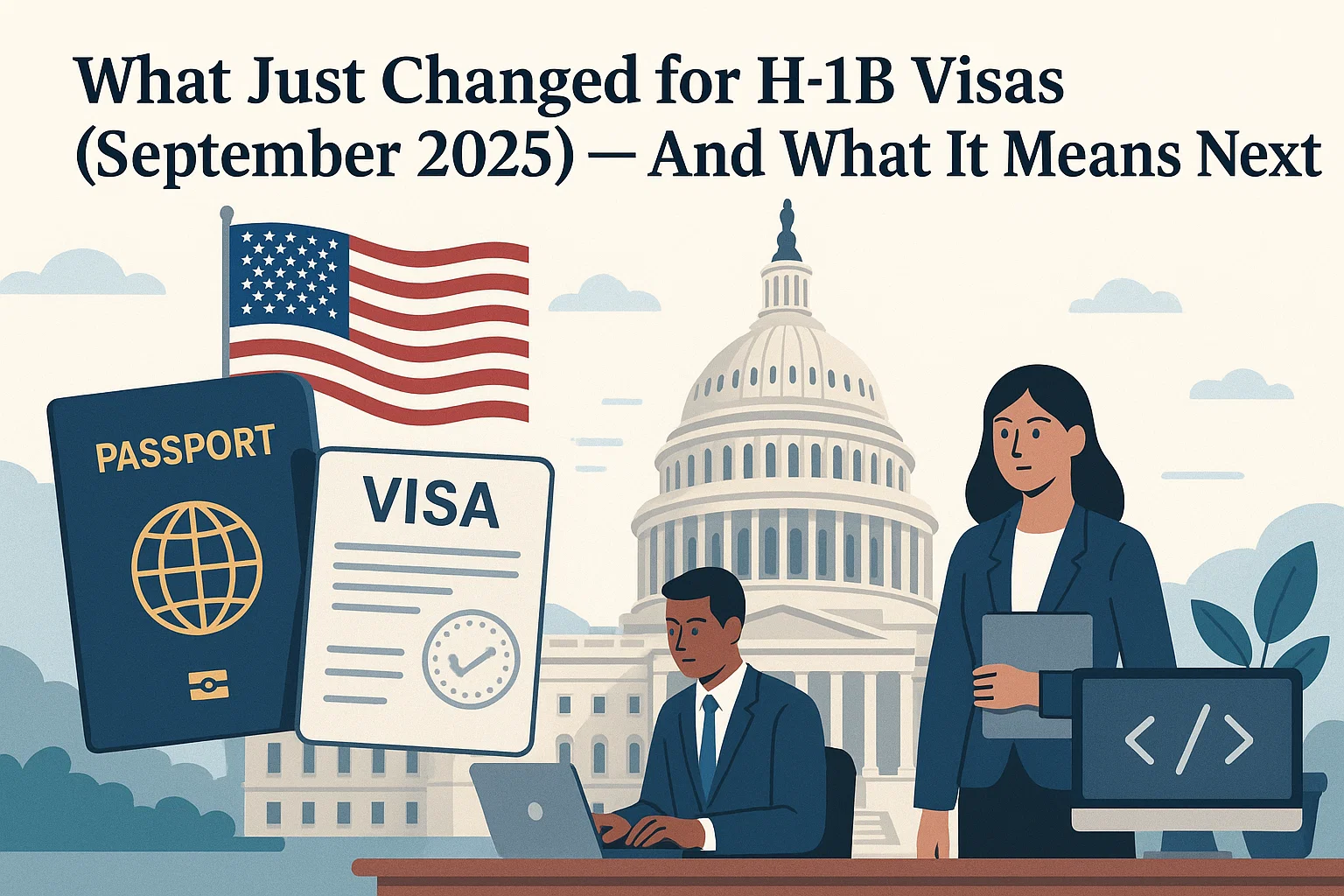What just changed for H-1B visas (September 2025) and what it means next
The H-1B visa has long been one of the most debated elements of U.S. immigration policy. For decades, it has provided a pathway for skilled foreign professionals to work in America, particularly in technology, research, and higher education. On September 19, 2025, President Donald Trump signed a new proclamation that changes this landscape dramatically.
This move introduces a $100,000 fee tied to H-1B petitions and entries and places conditions on entry for many current and future H-1B workers. The change is immediate, sweeping, and bound to create both legal battles and practical challenges.
In this blog, we’ll break down:
- What has changed in the H-1B visa policy under Trump.
- How the proclamation affects applicants, employers, and universities.
- Why this matters for the U.S. economy and global talent flows.
- What may happen next in terms of court rulings, Congress, and immigration practice.
Table of Contents
What Exactly Changed With Trump’s H-1B Proclamation
The $100,000 Fee
The most striking element of the proclamation is a $100,000 payment required for certain H-1B petitions and entries. Compared with existing filing fees and legal costs (typically in the $5,000–$10,000 range), this represents a seismic shift.
For many employers, particularly small and mid-sized businesses, this fee makes sponsoring an H-1B visa worker financially unviable. For large tech companies, the cost could still be absorbed, but it changes the calculus of hiring foreign talent.
Entry Restrictions
Alongside the fee, the proclamation restricts entry for H-1B visa holders unless the payment is made. Reports suggest this provision applies to workers traveling into the U.S. as of September 21, 2025. This means both new hires abroad and existing H-1B visa workers who travel internationally could face barriers at ports of entry.
Part of a Bigger Immigration Shift
The proclamation is not isolated. It comes amid the administration’s broader push to redesign immigration pathways. Alongside the H-1B changes, Trump announced new residency options like the so-called “Gold Card” and “Platinum Card” programs aimed at wealthy investors.
This dual track making skilled worker visas harder while offering fast-track options for the ultra-wealthy signals the administration’s clear policy direction.
Why These H-1B Changes Matter

H-1B’s Central Role in the U.S. Workforce
Each year, the H-1B visa program supports hundreds of thousands of workers across technology, healthcare, engineering, finance, and academia. Many universities rely on H-1B visas to employ researchers and professors in specialized fields.
Imposing a six-figure cost on entry or renewal disrupts not only tech firms like Google, Microsoft, and Infosys, but also mid-sized startups, hospitals, and colleges that cannot shoulder such expenses.
The Global Talent Impact
The U.S. has historically been the top destination for skilled workers worldwide. With Canada, the UK, and Australia competing aggressively for global talent, a steep barrier like this fee could redirect thousands of skilled workers elsewhere.
Market and Economic Consequences
Reuters, Financial Times, and other outlets reported that news of the fee sparked immediate concern in IT services and tech sectors. Offshore delivery models may expand, as companies find it easier to employ foreign talent remotely rather than bringing workers into the U.S.
Immediate Implications for Stakeholders
For H-1B Visa Applicants
- New applicants: The fee is a serious deterrent. Offers from U.S. companies may be paused or withdrawn. Expect longer uncertainty before start dates.
- Current visa holders: Renewals and extensions may depend on how DHS and USCIS implement the proclamation. Those planning travel abroad face special risk at re-entry checkpoints.
- Practical advice: Maintain strong documentation of legal status, and consult an immigration lawyer before international travel.
For Employers
- Cost implications: For startups and mid-sized companies, the new fee makes hiring H-1B workers virtually impossible. Larger corporations may still proceed but will rethink strategies for workforce planning.
- Operational steps:
- Review pending petitions.
- Reassess hiring strategies.
- Consider remote-first roles where employees remain based abroad.
- Legal risk: Employers should monitor DHS memos for details on whether the fee applies to extensions or in-country transfers.
For Universities and Research Institutions
Graduate students, postdoctoral researchers, and faculty often depend on H-1B Visa sponsorship. Academic leaders warn this policy could slow scientific output and international collaboration. Institutions will likely lobby for exemptions in fields deemed vital to U.S. research competitiveness.
For Source Countries and Trade Partners
India, which provides the largest share of H-1B visa workers, will feel this change most acutely. Diplomatic tensions may rise, and companies in Bangalore, Hyderabad, and Pune may scale up offshore delivery instead of investing in U.S.-based teams.
Contrasting Perspectives

The Administration’s Justification
The White House frames this measure as protecting U.S. jobs and curbing alleged abuses in the H-1B visa program. The logic is that only high-value petitions, those worth $100,000 or more to the employer will survive, ensuring U.S. workers aren’t displaced.
Critics’ Concerns
Tech companies, universities, and business coalitions argue the opposite. They warn that pricing out skilled foreign workers undermines U.S. competitiveness, slows innovation, and accelerates offshoring.
Policy Observers’ Middle Ground
Some immigration experts believe reforms are needed but argue for targeted changes, such as higher wage thresholds or stronger enforcement against fraud, rather than an across-the-board fee. Many legal scholars also question whether the President has the authority to impose such a fee without Congressional approval.
What Happens Next?
Likely Court Battles
Legal challenges are almost certain. Plaintiffs may argue that only Congress has the authority to set immigration fees and conditions. If courts agree, an injunction could temporarily block the policy.
Agency Guidance
The Department of Homeland Security (DHS) and U.S. Citizenship and Immigration Services (USCIS) will release memos clarifying who exactly pays, how the fee is collected, and whether renewals are covered. These documents will be crucial for compliance.
Possible Congressional Action
Lawmakers may respond with hearings or bills, either to support or strike down the proclamation. The path here depends heavily on political dynamics in Washington.
Checklist for Applicants and Employers
- Do not assume renewals are exempt. Confirm with counsel whether the proclamation applies to your situation.
- Avoid nonessential travel. International trips could complicate re-entry.
- Revisit hiring plans. Explore domestic hires, remote talent, or alternative visa categories (O-1 for extraordinary ability, L-1 for intra-company transfers, or TN for Canadian and Mexican workers).
- Monitor official sources. Keep watch on DHS and USCIS websites for updated FAQs and guidance.
Conclusion
Trump’s September 2025 proclamation is a watershed moment for the H-1B Visa program. By attaching a $100,000 fee and conditioning entry on payment, the policy reshapes the incentives for employers, applicants, and universities alike.
The coming months will likely bring lawsuits, agency memos, and political debates. For now, uncertainty is the rule. Applicants must exercise caution, employers must rethink workforce strategies, and policymakers must grapple with the balance between protecting domestic jobs and sustaining U.S. competitiveness.
In the global race for talent, decisions taken in Washington today will echo for years to come.
Reliable sources to follow now
White House proclamations and fact sheets. This is the primary legal text to read – The White House
Major wire services for up-to-the-minute coverage: Reuters, AP, Washington Post, Financial Times. – Reuters
DHS and USCIS (agency pages and rulemaking notices) for implementation guidance – USCIS
Immigration law firms and employer counsel for practical compliance memos. Early analyses are already circulating – Fragomen

